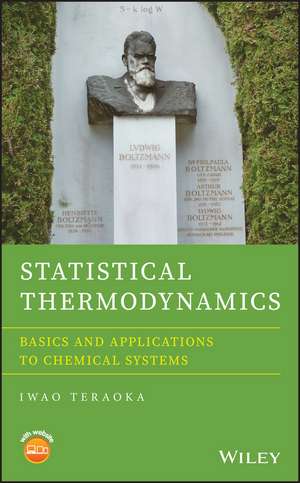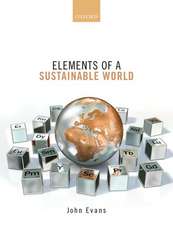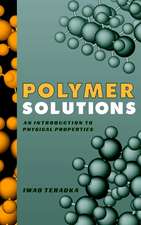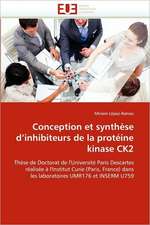Statistical Thermodynamics – Basics and Applications to Chemical Systems
Autor I Teraokaen Limba Engleză Hardback – 11 apr 2019
Preț: 632.61 lei
Preț vechi: 821.57 lei
-23% Nou
Puncte Express: 949
Preț estimativ în valută:
121.05€ • 126.71$ • 100.75£
121.05€ • 126.71$ • 100.75£
Carte tipărită la comandă
Livrare economică 31 martie-14 aprilie
Preluare comenzi: 021 569.72.76
Specificații
ISBN-13: 9781118305119
ISBN-10: 1118305116
Pagini: 352
Dimensiuni: 163 x 237 x 22 mm
Greutate: 0.64 kg
Editura: Wiley
Locul publicării:Hoboken, United States
ISBN-10: 1118305116
Pagini: 352
Dimensiuni: 163 x 237 x 22 mm
Greutate: 0.64 kg
Editura: Wiley
Locul publicării:Hoboken, United States
Public țintă
Undergraduate and graduate students studying chemistry, chemical engineering, materials science, and other related programs.Notă biografică
IWAO TERAOKA, PHD, is a professor of chemistry at Tandon School of Engineering of NYU. His current research areas include photonic sensors and liquid chromatography, but in early years he worked on physical chemistry of polymer solutions. He is a recipient of the 1994 NSF Young Investigator Award. Professor Teraoka is also the author of Polymer Solutions: An Introduction to Physical Properties and more than 100 original papers and 6 book chapters.
Cuprins
Preface xiii
Acknowledgments xvii
About the Companion Website xix
Symbols and Constants xxi
1 Introduction 1
1.1 Classical Thermodynamics and Statistical Thermodynamics 1
1.2 Examples of Results Obtained from Statistical Thermodynamics 2
1.2.1 Heat Capacity of Gas of Diatomic Molecules 2
1.2.2 Heat Capacity of a Solid 3
1.2.3 Blackbody Radiation 3
1.2.4 Adsorption 4
1.2.5 Helix-Coil Transition 5
1.2.6 Boltzmann Factor 6
1.3 Practices of Notation 6
2 Review of Probability Theory 9
2.1 Probability 9
2.2 Discrete Distributions 11
2.2.1 Binomial Distribution 12
2.2.2 Poisson Distribution 13
2.2.3 Multinomial Distribution 14
2.3 Continuous Distributions 15
2.3.1 Uniform Distribution 19
2.3.2 Exponential Distribution 19
2.3.3 Normal Distribution 21
2.3.4 Distribution of a Dihedral Angle 21
2.4 Means and Variances 22
2.4.1 Discrete Distributions 22
2.4.2 Continuous Distributions 26
2.4.3 Central Limit Theorem 27
2.5 Uncertainty 28
Problems 31
3 Energy and Interactions 35
3.1 Kinetic Energy and Potential Energy of Atoms and Ions 35
3.1.1 Kinetic Energy 35
3.1.2 Gravitational Potential 36
3.1.3 Ion in an Electric Field 36
3.1.4 Total Energy of Atoms and Ions 37
3.2 Kinetic Energy and Potential Energy of Diatomic Molecules 37
3.2.1 Kinetic Energy (Translation, Rotation, Vibration) 37
3.2.2 Dipolar Potential 42
3.2.2.1 Potential of a Permanent Dipole 42
3.2.2.2 Potential of an Induced Dipole 44
3.3 Kinetic Energy of Polyatomic Molecules 46
3.3.1 Linear Polyatomic Molecule 46
3.3.2 Nonlinear Polyatomic Molecule 48
3.4 Interactions Between Molecules 50
3.4.1 Excluded-Volume Interaction 52
3.4.2 Coulomb Interaction 52
3.4.3 Dipole-Dipole Interaction 53
3.4.4 van der Waals Interaction 54
3.4.5 Lennard-Jones Potential 55
3.5 Energy as an Extensive Property 57
3.6 Kinetic Energy of a Gas Molecule in Quantum Mechanics 58
3.6.1 Quantization of Translational Energy 58
3.6.2 Quantization of Rotational Energy 61
3.6.3 Quantization of Vibrational Energy 63
3.6.4 Electronic Energy Levels 65
3.6.5 Comparison of Energy Level Spacings 66
Problems 67
4 Statistical Mechanics 69
4.1 Basic Assumptions, Microcanonical Ensembles, and Canonical Ensembles 69
4.1.1 Basic Assumptions 69
4.1.2 Microcanonical Ensembles 73
4.1.3 Canonical Ensembles 75
4.2 Probability Distribution in Canonical Ensembles and Partition Functions 77
4.2.1 Probability Distribution 77
4.2.2 Partition Function for a System with Discrete States 79
4.2.3 Partition Function for a System with Continuous States 81
4.2.4 Energy Levels and States 83
4.3 Internal Energy 88
4.4 Identification of beta 89
4.5 Equipartition Law 91
4.6 Other Thermodynamic Functions 93
4.7 Another View of Entropy 97
4.8 Fluctuations of Energy 99
4.9 Grand Canonical Ensembles 100
4.10 Cumulants of Energy 107
Problems 110
5 Canonical Ensemble of Gas Molecules 113
5.1 Velocity of Gas Molecules 113
5.2 Heat Capacity of a Classical Gas 116
5.2.1 Point Mass 117
5.2.2 Rigid Dumbbell 117
5.2.3 Elastic Dumbbell 118
5.3 Heat Capacity of a Quantum-Mechanical Gas 120
5.3.1 General Formulas 120
5.3.2 Translation 122
5.3.3 Rotation 124
5.3.4 Vibration 127
5.3.5 Comparison with Classical Models 128
5.4 Distribution of Rotational Energy Levels 129
5.5 Conformations of a Molecule 130
Problems 132
6 Indistinguishable Particles 135
6.1 Distinguishable Particles and Indistinguishable Particles 135
6.2 Partition Function of Indistinguishable Particles 137
6.2.1 System of Distinguishable Particles 137
6.2.2 System of Indistinguishable Particles 137
6.3 Condition of Nondegeneracy 142
6.4 Significance of Division by N! 144
6.4.1 Gas in a Two-Part Box 144
6.4.2 Chemical Potential 145
6.4.3 Mixture of Two Gases 146
6.5 Indistinguishability and Center-of-Mass Movement 147
6.6 Open System of Gas 147
Problems 149
7 Imperfect Gas 153
7.1 Virial Expansion 153
7.2 Molecular Expression of Interaction in the Canonical Ensemble 157
7.3 Second Virial Coefficients in Different Models 164
7.3.1 Hard-Core Repulsion Only 164
7.3.2 Square-well Potential 165
7.3.3 Lennard-Jones Potential 167
7.4 Joule-Thomson Effect 167
Problems 171
8 Rubber Elasticity 175
8.1 Rubber 175
8.2 Polymer Chain in One Dimension 176
8.3 Polymer Chain in Three Dimensions 180
8.4 Network of Springs 184
Problems 185
9 Law of Mass Action 189
9.1 Reaction of Two Monatomic Molecules 190
9.2 Decomposition of Homonuclear Diatomic Molecules 193
9.3 Isomerization 195
9.4 Method of the Steepest Descent 197
Problems 198
10 Adsorption 201
10.1 Adsorption Phenomena 201
10.2 Langmuir Isotherm 202
10.3 BET Isotherm 206
10.4 Dissociative Adsorption 211
10.5 Interaction Between Adsorbed Molecules 213
Problems 213
11 Ising Model 217
11.1 Model 217
11.2 Partition Function 220
11.2.1 One-Dimensional Ising Model 220
11.2.2 Calculating Statistical Averages 221
11.2.2.1 Average Number of Up Spins 222
11.2.2.2 Average of the Number of Spin Alterations (Number of Domains - 1) 222
11.2.2.3 Domain Size 223
11.2.2.4 Size of a Domain of Uniform Spins 223
11.2.3 A Few Examples of 1D Ising Model 223
11.2.3.1 Linear Ising Model, N = 3 223
11.2.3.2 Ring Ising Model, N = 3 225
11.2.3.3 Ring Ising Model, N = 4 225
11.3 Mean-FieldTheories 226
11.3.1 Bragg-Williams (B-W) Approximation 227
11.3.2 Flory-Huggins (F-H) Approximation 231
11.3.3 Approximation by a Mean-Field (MF) Theory 235
11.4 Exact Solution of 1D Ising Model 236
11.4.1 General Formula 236
11.4.2 Large-N Approximation 239
11.4.3 Exact Partition Function for Arbitrary N 241
11.4.4 Ring Ising Model, Arbitrary N 244
11.4.5 Comparison of the Exact Results with Those of Mean-Field Approximations 245
11.5 Variations of the Ising Model 247
11.5.1 System of Uniform Spins 247
11.5.2 Random Local Fields of Opposite Directions 249
11.5.3 Dilute Local Fields 252
Problems 254
12 Helical Polymer 263
12.1 Helix-Forming Polymer 263
12.2 Optical Rotation and Circular Dichroism 266
12.3 Pristine Poly(n-hexyl isocyanate) 267
12.4 Variations to the Helical Polymer 271
12.4.1 Copolymer of Chiral and Achiral Isocyanate Monomers 272
12.4.2 Copolymer of R- and S-Enantiomers of Isocyanate 274
Problems 274
13 Helix-Coil Transition 277
13.1 Historical Background 277
13.2 Polypeptides 281
13.3 Zimm-Bragg Model 283
Problems 289
14 Regular Solutions 291
14.1 Binary Mixture of Equal-Size Molecules 291
14.1.1 Free Energy of Mixing 291
14.1.2 Derivatives of the Free Energy of Mixing 296
14.1.3 Phase Separation 300
14.2 Binary Mixture of Molecules of Different Sizes 304
Problems 312
Appendix A Mathematics 315
A.1 Hyperbolic Functions 315
A.2 Series 317
A.3 Binomial Theorem and Trinomial Theorem 317
A.4 Stirling's formula 318
A.5 Integrals 318
A.6 Error Functions 318
A.7 Gamma Functions 319
References 321
Index 325
















